 |
 |
 |
 |
|
The Continuing Invasion of Dadu
|
||||||||||||||||||||||||||||||||||||||||
| Kublai Khan, grandson of Chinggis, established his city (Dadu, meaning "big capital") south of the Great Wall, what is now Beijing. Little, of course, is left of the Yuan dynasty capital, but in exploring this vast city it's easy to find little pockets of ancient China. One year before the 2008 Olympics, Beijing's growing pains have gotten totally frenetic, getting the city ready for its 21st century global debut. | ||||||||||||||||||||||||||||||||||||||||
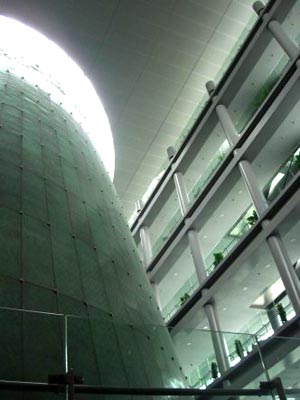 |
On our return, we got to sleep in until lunch, then visited the new Capital Museum. Exhibits here focus on the city's history and culture, housed in a massive five or six story blocky building. Inside, though, it's marvellous: a huge atrium with escalators to the top, the main area divided into little mazes of porcelain, reconstructed alley ways and temples, sculpture, flags, and memorabilia from all periods. I decided to start from the top floor and work down, and the first room I entered was a display on Beijing opera. The first exhibit was a costume from one of Mei Lanfang's productions of Si Lang Tian Mu — so I was once again a happy camper! I wandered through the other sections, found an oracle bone, admired some of the modern paintings in a current first floor exhibit; then discovered that the calligraphy and jade were in a tube-like wing on teh other side of the lobby. The museum's brush painting and calligraphy collections are quite impressive, and date as far back as the Song dynasty. |
|||||||||||||||||||||||||||||||||||||||
| On the way back the bus made a stop at the Silk Market for those who wanted to shop. Our final exam was scheduled for just before dinner, and most of us had not done much studying. I for one don't find interminable delays in airports conducive to doing much of anything. The market — another six floors of goods, but here the stalls were manned by overly aggressive salespeople — was packed. After a couple of futile attempts to get on an elevator, I went back to the bus and reread my notes. Sadly (for those of the group not staying behind) our last dinner was in our hotel, whose food had not improved while we were away on the steppes. Nor was the dining room optimum for taking a pre-meal exam (which Bob said he would take into account during grading). Only one of us, Tom, was taking the class for a grade, anyway. The rest of the evening was pretty much anti-climax: short walks, trips to the Merry Mart for extra suitcases and airplane snacks, one or two people may have gone in search of a foot massage or karaoke, packing. I saw everyone off after breakfast the next morning, got my lodgings sorted out (more or less: the hotel had Bob and me confused for a few days and kept sending phone calls to the wrong room), and got into local relaxation mode. I felt disinclined to explore distant areas of Beijing, involving taxis or public transportation, so I took walks in various directions from the hotel, returning after a few hours to strip off my web clothes and channel surf. To my delight, daytime programming on TV included runs of Yi Tian Tu Long Ji on three different channels, plus Diao Man Gong Zhu on another. I also stumbled across a half-hour program on Su You Peng: some recent news and clips from two 2004-era interviews that ran twice one evening. The poor housekeeping staff had to telephone me one day and ask when they could clean my room; they had missed my morning outing and I was in "midday nap" mode. (I tipped them well.) Monday evening I was free as the BJ fans wanted to get together on Tuesday for dinner. I had done quite a bit of walking, and was happy to veg out for the evening in my room. |
||||||||||||||||||||||||||||||||||||||||
 |
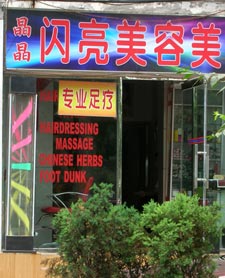 |
|||||||||||||||||||||||||||||||||||||||
| This is a good spot to display a selection of some of the wonderful Beijing signage, and a segue into my class field journal notes: | ||||||||||||||||||||||||||||||||||||||||
 |
||||||||||||||||||||||||||||||||||||||||
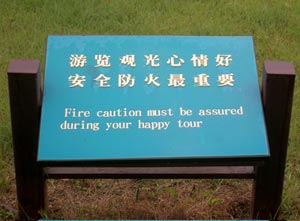 |
||||||||||||||||||||||||||||||||||||||||
| Getting happy and clean: no problem! |
||||||||||||||||||||||||||||||||||||||||
|
Project: Use of Traditional Cultural Motifs in Modern Graphic Design
As a graphic designer I am interested in the origins of decorative motifs: in logos, advertising, signs, clothing and jewelry, etc. Two initial observations that have piqued my interest in this topic for this summer program are: 1. Beijing 2008 Olympics: The China games organizers have created a very thoughtful campaign for 2008, as part of their concentrated efforts to use the events to both improve the cultural climate in Beijing (from decreasing environmental pollution to improving the English used in signage) and promote China and Beijing in the eyes of the world. The main logo is a stylized seal using ancient Chinese calligraphy — the character for "jing" manipulated to resemble a running figure. The cartoon "five friendlies" incorporate the Chinese elements in the colors (red, green, blue, yellow, and black, which are also the Olympic colors), and the characters themselves symbolize Chinese animals. 2. Mongolian embroidery: An account in one of the books on Mongolia described a tradition in which, when a woman marries, she begins to decorate her family's ger with embroidery — a project lasting decades are more and more pieces are added. In this book the observer describes one pillow that was embroidered with phoenixes and Mickey Mouse. I wanted to see if this indicated an ongoing combination of the old and the new as the culture changes. Observations: China Beijing: The Olympics are everywhere! Billboards from corporate sponsors, ads on television, hawkers selling t-shirts (even on the Great Wall). We passed by the new Olympics village area to see the stadium being built to house opening and closing ceremonies. This amazing structure known locally as the "bird's nest" is a massive crisscross of metal that really does resemble a bird's nest (an element seen in many Chinese paintings, not to mention soup). The buildings are located on the North-South meridian that defines the city of Beijing, where directional feng shui has always had a major impact on construction. All of the important historical buildings in Beijing (the Forbidden City, the Temple of Heaven, the north and south old city gates, etc.) bisect this N-S line. (Another new Olympics building, the "ice cube" which will house swimming events, is equally awesome but less culturally motivated, as far as I can tell.) The Five Friendlies: There are entire web sites for these guys, promoting the 2008 Olympics from a number of perspectives. The characters (called "Fuwa") represent four of the animals important to China: panda, antelope, swallow and a fish. The fifth is the Olympic flame (also the "fire" element important to Chinese symbology). Here's some official verbiage: I was surprised that there seems to be no color element symbology, as this would seem obvious. They make good gifts for kids, that's for sure, from little electronics tags to lapel pins to stuffed toys. |
||||||||||||||||||||||||||||||||||||||||
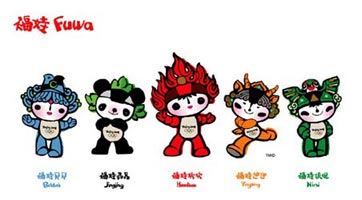 |
 |
|||||||||||||||||||||||||||||||||||||||
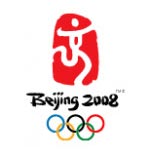 |
||||||||||||||||||||||||||||||||||||||||
| The Bird's Nest at night | ||||||||||||||||||||||||||||||||||||||||
| Logos for the 2008 Beijing Olympics | ||||||||||||||||||||||||||||||||||||||||
| Calligraphy: I paid a lot of attention to the lettering on store signs, billboards, posters, brochures, etc. Official government billboards mostly use a blocky font that is easily recognized once you first notice it. These often have sociopolitical slogans, and use scenic photos and/or images of ethnic minority peoples (many from SW China; we saw more of these last year in Guizhou and Yunnan but they are also found in the north), soldiers, etc. Cursive fonts are common, as is a particularly elaborate (and difficult to read!) decorative font I don't remember noticing last year but is the same as the one used for SYP's new CD single. So maybe this is a currently popular style. |
||||||||||||||||||||||||||||||||||||||||
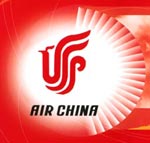 |
||||||||||||||||||||||||||||||||||||||||
| Motifs: Seals, calligraphic images (i.e., graphics resembling written characters) and traditional animal images are used for advertising or promotional pieces. Dragons and phoenixes are very common. This year the image of the pig is quite often seen. Stylized logos with these images can be found, although not as often as I expected (many images are photographic or detailed drawings). The "flying horse" (a statue found in one of the early tombs) has become the official image for China tourism. We saw statues in Chengde and near the Hanging Monastery. Tickets at the Hanging Monastery had another logo that looked like a very stylized pig; however, nobody I asked was able to tell me its origin or whether it was widely used. |
||||||||||||||||||||||||||||||||||||||||
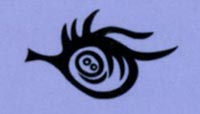 |
||||||||||||||||||||||||||||||||||||||||
| The Great Wall: Used for a variety of products (including wine) as well as tourism-directed items targeted to the West. Not sure of the impact within China advertising. |
||||||||||||||||||||||||||||||||||||||||
 |
Pop stars: I saw fewer of these this year, but we did not spend as much time in market areas. Yao Ming, Jackie Chan and one other male star (an athlete?) are the main stars in Olympics advertising materials. Jay Chou is still the Pepsi rep, and seems to also be the current king of promotions. Poor Leon Lai was stuck in a BJ alley close to our hotel (see above), but I saw Karen Mok (jewelry and clothes) and Aaron Kwok ("Wolf's Head" line) in ads for high end goods in Datong and on TV. Datong also had a street-long parade of Jet Li ads. This city seems to be a thriving shopping center; all types of shops with plenty of celebrities, including a Lanswe store (sadly no posters here although the packaged socks and underwear did have SYP's image). |
|||||||||||||||||||||||||||||||||||||||
| Leon Lai's alley in BJ | ||||||||||||||||||||||||||||||||||||||||
|
Mongolia Petroglyphs are also very popular images — and Mongolia has a lot of petroglyphs and cave paintings. We saw an entire room full of these in the National Museum of Mongolian History in UB. I also saw petroglyph images used as store and product logos; e.g. the Red Horse Pub & Restaurant near one of the museums. [see photo] The Mongolian flag is chock full of symbolic imagery: • the flame or fire symbolizes purity • sun and moon (pantheistic dieties) • arrows: protection from enemies from within and without • bars: equality • yin/yang or two fishes with eyes open: protection • side bars: borders of Mongolia The flag imagery was also developed into a character in the Mongolian alphabet that represents "Mongolia" |
||||||||||||||||||||||||||||||||||||||||
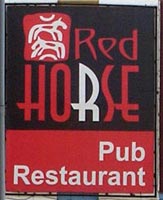 |
||||||||||||||||||||||||||||||||||||||||
 |
||||||||||||||||||||||||||||||||||||||||
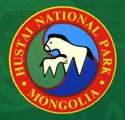 |
||||||||||||||||||||||||||||||||||||||||
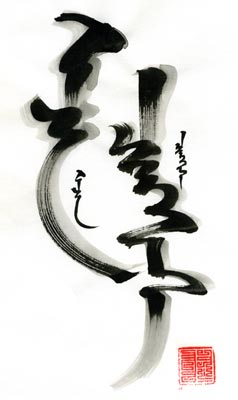 |
Advertising in Mongolia: Mostly uses Cyrillic Mongolian characters with photo images of glamorous people (local celebrities?). Many billboards are rather ugly, and the lettering is blocky and pretty boring. English is used for restaurant and bar signs, but rarely for stores (except CD/DVD stores which are called "Happy Store"). Most billboard signs are in Mongolian, with very little English (contrasted with China where English is often seen). Mongolian calligraphic script is used in Inner Mongolia but not in Mongolia, which changed to a Cyrillic alphabet during the period of Russian influence. (According to our guide Ayush, there was a popular movement in the 1990s to change back to traditional script, which started being taught in schools, but the problems and expense of reprinting were prohibitive. Currently the script is only used by academics, and for art pieces, which are often very beautiful.) |
|||||||||||||||||||||||||||||||||||||||
| Calligraphic art: "Sun and Moon" in Mongolian script | ||||||||||||||||||||||||||||||||||||||||